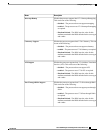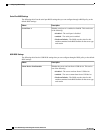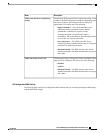
DescriptionName
The amount of power available to the server components when
they are idle. This can be one of the following:
• c0—The server provides all server components with full
power at all times. This option maintains the highest level
of performance and requires the greatest amount of power.
• c1—When the CPU is idle, the system slightly reduces
the power consumption. This option requires less power
than C0 and allows the server to return quickly to high
performance mode.
• c3—When the CPU is idle, the system reduces the power
consumption further than with the C1 option. This requires
less power than C1 or C0, but it takes the server slightly
longer to return to high performance mode.
• c6—When the CPU is idle, the system reduces the power
consumption further than with the C3 option. This option
saves more power than C0, C1, or C3, but there may be
performance issues until the server returns to full power.
• no-limit—The server may enter any available C state.
• Platform Default—The BIOS uses the value for this
attribute contained in the BIOS defaults for the server type
and vendor.
Package C State Limit
Intel Directed I/O BIOS Settings
The following table lists the Intel Directed I/O BIOS settings that you can configure through a BIOS policy
or the default BIOS settings:
DescriptionName
Whether the processor uses Intel Virtualization Technology for
Directed I/O (VT-d). This can be one of the following:
• disabled—The processor does not use virtualization
technology.
• enabled—The processor uses virtualization technology.
• Platform Default—The BIOS uses the value for this
attribute contained in the BIOS defaults for the server type
and vendor.
This option must be enabled if you want to change any
of the other Intel Directed I/O BIOS settings.
Note
VT for Directed IO
Cisco UCS Manager GUI Configuration Guide, Release 2.0
390 OL-25712-04
Configuring BIOS Settings


















